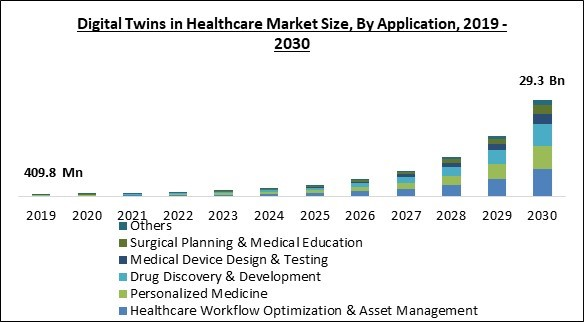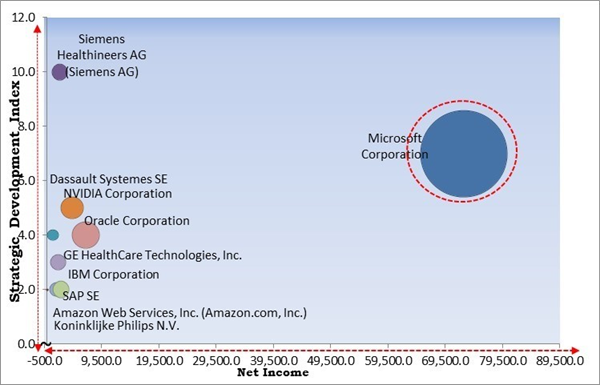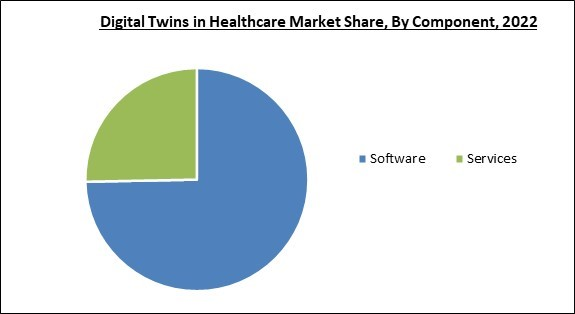The surgical planning & medical education is capturing the market as the development of digital twin algorithms for surgery has recently been the focus of extensive scientific projects around the globe. Hence, surgical planning & medical education registered $81.3 million revenue in the market in 2022. With excellent accuracy, surgical digital twins track and update virtual replicas of physical elements in real time. Scheduling may be improved, error probability can be reduced, and supply chain management can be strengthened using machine learning and data analytics. Due to widespread usage and the desire for high precision, the market is expected to expand.
The major strategies followed by the market participants are Partnerships as the key developmental strategy to keep pace with the changing demands of end users. For instance, In August, 2021, IBM came into collaboration with Black & Veatch to help customers keep assets and equipment running at peak performance and reliability. Additionally, In April, 2023, Oracle collaborated with Deloitte to include operations, implementation, and advisory services for Oracle through Deloitte Health - Oracle Accelerated. In November, 2022, SAP came into an agreement with Schneider Electric to improve digital transformation and industry innovation to simplify onboarding and lifecycle management of assets with digital twins, augmented and virtual reality.
The Cardinal Matrix - Market Competition Analysis
Based on the Analysis presented in the The Cardinal Matrix; Microsoft Corporation is the forerunner in the Market. In March, 2022, Microsoft teamed up with Cognizant to deliver a new digital health solution to improve remote patient monitoring for better medical care. Companies such as Siemens Healthineers AG (Siemens AG), Dassault Systemes SE and Oracle Corporation are some of the key innovators in the Market.
COVID-19 Impact
In order to improve processes and forecast how effectively the facilities will be able to handle the increased patient influx that was seen during the pandemic, healthcare facilities used digital twins after the outbreak. In order to meet the rising demand, pharmaceutical companies used technology to manufacture vaccinations. To increase the effectiveness of the processes, digital twins were employed to create real-time simulations of the physical processes involved in making vaccines.Market Growth Factors
Rising investment in digital twin technology
The concept of generating a virtual clone of a real-world system, process, or object has gained popularity in recent years. This technology is known as "digital twin technology." As a result, both public & private companies have been expanding their investment in digital twin technology due to their growing awareness of the technology's ability to spur innovation and raise operational effectiveness. The public and privatesectors' investments will hasten the advancement and uptake of the technology behind digital twins. The expansion of the healthcare market will be boosted in the upcoming years by creating new opportunities.Growth of remote monitoring services and telemedicine
The medication intake, blood sugar levels, and other significant health indicators of a diabetic patient can be tracked using the patient's digital twin. In order to help manage the disease, it may also be employed to advise what to eat, how much to exercise, and other lifestyle changes. The use of digital twin technologies in healthcare can also increase the effectiveness and efficiency of remote patient monitoring and telemedicine by giving a more accurate and comprehensive picture of the patient's health. This could aid medical professionals in efficiently managing and monitoring their patients. So, in the next years, it is anticipated that the growth of telemedicine and remote patient monitoring services will expand the market.Market Restraining Factors
Dearth of technical expertise and issues with data management
Digital twin technology implementation and upkeep in the healthcare industry call for specialized training and expertise in data science, software engineering, and machine learning. It can be difficult to adjust to this emerging technology, particularly in the healthcare industry, with enormous warehouses of unstructured data. Healthcare companies may experience delays, increased expenses, and restricted access to the advantages of digital twins technology if there are insufficiently qualified individuals to implement,design, and manage this technology. These factors make it likely that the market will develop slowly over the forecast period.Component Outlook
Based on component, the market is segmented into software, and services. The services segment acquired a substantial revenue share in the market in 2022. The significant market share of this segment is a result of the expanding demand for services that assist businesses in efficiently implementing and utilizing digital twin technology and maximizing its advantages. Data administration, analysis, and support, as well as maintenance and advising services, are all included in this segment of the market.Application Outlook
On the basis of application, the market is fragmented into drug discovery & development, personalized medicine, surgical planning & medical education, medical device design & testing, healthcare workflow optimization & asset management, and others. The surgical planning & medical education segment garnered a significant revenue share in the market in 2022. The development of digital twin algorithms for surgery has recently been the focus of extensive scientific projects around the globe. With excellent accuracy, surgical digital twins track and update virtual replicas of physical elements in real time. Due to widespread usage and the desire for high precision, the market is expected to expand.End-user Outlook
By end user, the market is classified into pharma & bio-pharma companies, research & academia, providers, medical device companies and others. In 2022, the providers segment dominated the market by generating the largest revenue share. The development of digital twins in healthcare is anticipated to be extremely significant. The term "smart hospitals" refers to the widespread use of this technology in hospitals & clinics. A smart hospital is Internet Protocol (IP) capable, has Internet of Things (IoT) sensors to communicate data, and combines data from many subsystems with real-time interactions between patients, staff members, and linked gadgets. Market participants who are active in the market work together to acquire a competitive advantage over others.Regional Outlook
Region wise, the market is fragmented into North America, Europe, Asia Pacific and LAMEA. The North America region led the market with the maximum revenue share in 2022. Due to the increased use of digital twins in healthcare in this region, it is predicted that this region will dominate the market throughout the projected period. The market's success in the region is influenced by several factors, including the rise in the availability of better healthcare facilities, particularly in hospitals and ambulatory surgery centers, the ongoing development of medical technologies, and the profitable presence of key players in the US and Canada.The market research report covers the analysis of key stake holders of the market. Key companies profiled in the report include Siemens Healthineers AG (Siemens AG), Dassault Systemes SE, Microsoft Corporation, Koninklijke Philips N.V., IBM Corporation, NVIDIA Corporation, GE HealthCare Technologies, Inc., Oracle Corporation, Amazon Web Services, Inc. (Amazon.com, Inc.), and SAP SE.
Strategies Deployed in the Market
Partnerships, Collaborations and Agreements:
- Jun-2023: NVIDIA collaborated with Hexagon, a digital reality vendor. This collaboration aims to build industrial digital twin products and help companies move toward the metaverse.
- Apr-2023: Oracle collaborated with Deloitte, a provider of audit and assurance, financial advisory, tax, and risk advisory. This collaboration broadens Deloitte's operating system for healthcare to include operations, implementation, and advisory services for Oracle through Deloitte Health - Oracle Accelerated.
- Jan-2023: Dassault Systèmes came into collaboration with IBM, an American multinational technology corporation. Under this collaboration, the integration of Dassault Systemes' 3DEXPERIENCE platform and virtual twin experiences, and IBM's asset management, IoT platform, and environmental intelligence portfolio would provide actionable insights and solutions for optimizing operations, boosting sustainability outcomes, and enhancing assets.
- Nov-2022: SAP came into an agreement with Schneider Electric, a global specialist in energy management and automation. Following the agreement, both companies plan to explore opportunities to improve digital transformation and industry innovation to simplify onboarding and lifecycle management of assets with digital twins, augmented and virtual reality.
- Nov-2022: Dassault Systèmes partnered with Sanofi, the French multinational pharmaceutical and healthcare company. Under this partnership, Dassault would aim to optimize 'Evolutive Facility' production at Sanofi's future modular manufacturing facilities across Singapore and France.
- Jul-2022: Amazon Web Services came into partnership with Procore, a construction management software, on digital twin technology. Under this partnership, AWS' proprietary IoT TwinMaker, allows users to create their digital twins to connect directly to Procore's software and share data across the programs, organizing operations and maintenance.
- Apr-2022: Oracle Cloud Infrastructure came into partnership with Maplesoft, a manufacturer of the Maple computer algebra system, and MapleSim physical modeling and simulation software. With Oracle's cloud technology and Maplesoft's simulation software, its customers would integrate operational data at scale with physics-based models to build highly diverse digital twins.
- Mar-2022: Microsoft teamed up with Cognizant, a US-based information technology services and consulting company. Following this collaboration, companies aim to deliver a new digital health solution to improve remote patient monitoring for better medical care.
- Aug-2021: IBM came into collaboration with Black & Veatch, a global engineering, procurement, consulting, and construction company leading in infrastructure development. Under this alliance, both companies would jointly commercialize Asset Performance Management (APM) solutions, consisting of remote monitoring technologies that integrate near real-time data analytics with artificial intelligence to help customers keep assets and equipment running at peak performance and reliability.
- Jul-2021: Royal Philips collaborated with Cognizant, an American multinational information technology services and consulting company. The collaboration aims to develop complete digital health solutions which would allow healthcare companies and life sciences companies to enhance patient care and boost clinical trials.
Product Launches and Product Expansions:
- Jun-2022: NVIDIA introduced NVIDIA Clara Holoscan MGX platform, a Medical AI Computing Platform. The solution for medical devices that integrates hardware systems and optimized libraries for AI and data processing broadens NVIDIA's current medical device ecosystem to offer medical-grade reference architecture and long-term support.
Mergers and Acquisitions:
- Apr-2021: Siemens took over Varian Medical Systems, a U.S. company active in the region of cancer research & therapy. This acquisition would allow Siemens to strengthen the competitiveness & independence of Siemens Healthineers. The acquisition further focused on creating a world-leading company in cancer therapy.
Scope of the Study
By Application
- Healthcare Workflow Optimization & Asset Management
- Personalized Medicine
- Drug Discovery & Development
- Medical Device Design & Testing
- Surgical Planning & Medical Education
- Others
By Component
- Software
- Services
By End-user
- Providers
- Pharma & Biopharma Companies
- Research & Academia
- Medical Device Companies
- Others
By Geography
- North America
- US
- Canada
- Mexico
- Rest of North America
- Europe
- Germany
- UK
- France
- Russia
- Spain
- Italy
- Rest of Europe
- Asia Pacific
- China
- Japan
- India
- South Korea
- Singapore
- Malaysia
- Rest of Asia Pacific
- LAMEA
- Brazil
- Argentina
- UAE
- Saudi Arabia
- South Africa
- Nigeria
- Rest of LAMEA
Key Market Players
List of Companies Profiled in the Report:
- Siemens Healthineers AG (Siemens AG)
- Dassault Systemes SE
- Microsoft Corporation
- Koninklijke Philips N.V.
- IBM Corporation
- NVIDIA Corporation
- GE HealthCare Technologies, Inc.
- Oracle Corporation
- Amazon Web Services, Inc. (Amazon.com, Inc.)
- SAP SE
Unique Offerings
- Exhaustive coverage
- The highest number of Market tables and figures
- Subscription-based model available
- Guaranteed best price
- Assured post sales research support with 10% customization free
Table of Contents
Companies Mentioned
- Siemens Healthineers AG (Siemens AG)
- Dassault Systemes SE
- Microsoft Corporation
- Koninklijke Philips N.V.
- IBM Corporation
- NVIDIA Corporation
- GE HealthCare Technologies, Inc.
- Oracle Corporation
- Amazon Web Services, Inc. (Amazon.com, Inc.)
- SAP SE











